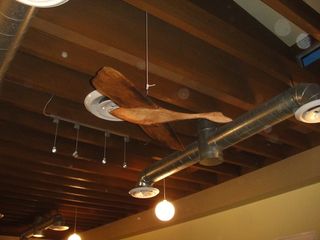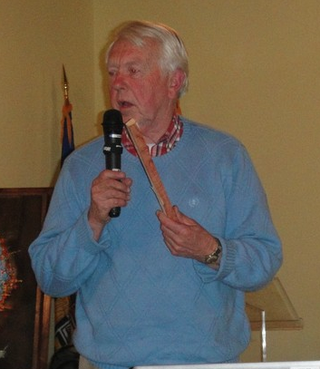Robert HIlton demonstrates his musical instruments made from found wood and other materials at the Altadena Heritage meeting Wed., March 28, 2012. Video and all photos by Laura Monteros.
by Laura Monteros
So what does one do with the downed eucalyptus tree in the back yard or Chinese elm in front that sorely needs trimming? Call in the urban lumberjacks!
These folks can take a chunk of cast-off wood and create one-of-a-kind pieces from designer furniture to desk pens. Artist Robert Hilton even makes music with branches he has turned into blown and stringed instruments.
 Rich Benson, JPL engineer, urban lumberjack, and Altadena Heritage board member opened the program sponsored by Altadena Heritage on Wednesday night. He got into lumberjacking when his father built a home in Michigan and had to clear away maple trees to make room for it.
Rich Benson, JPL engineer, urban lumberjack, and Altadena Heritage board member opened the program sponsored by Altadena Heritage on Wednesday night. He got into lumberjacking when his father built a home in Michigan and had to clear away maple trees to make room for it.
 Rich Benson, JPL engineer, urban lumberjack, and Altadena Heritage board member opened the program sponsored by Altadena Heritage on Wednesday night. He got into lumberjacking when his father built a home in Michigan and had to clear away maple trees to make room for it.
Rich Benson, JPL engineer, urban lumberjack, and Altadena Heritage board member opened the program sponsored by Altadena Heritage on Wednesday night. He got into lumberjacking when his father built a home in Michigan and had to clear away maple trees to make room for it.Rich Benson's Canada goose is made from pecan wood.
Benson talked about the steps to harvesting urban lumber and the equipment needed as well as the benefits of using wood that might otherwise end up in a landfill. He said it reduces pressure on landfills and forest logging, reduces the cost of lumber for woodworkers, enables people to have custom pieces, and is something relaxing to do.
The list of equipment is fairly long and expensive, but there was one tool that might be worth the price: an old-fashioned, two-man handsaw. Benson noted that if a husband and wife cut down a tree together, “it can save on marital counseling.”
In addition to logging and preserving wood, Benson makes furniture and household items. He had several samples of cut and sectioned wood to show the difference in grains and color, and displayed a bench made from a tree removed from in front of Vroman’s Bookstore and a Canada goose crafted from pecan wood.
Benson talked about the steps to harvesting urban lumber and the equipment needed as well as the benefits of using wood that might otherwise end up in a landfill. He said it reduces pressure on landfills and forest logging, reduces the cost of lumber for woodworkers, enables people to have custom pieces, and is something relaxing to do.
The list of equipment is fairly long and expensive, but there was one tool that might be worth the price: an old-fashioned, two-man handsaw. Benson noted that if a husband and wife cut down a tree together, “it can save on marital counseling.”
In addition to logging and preserving wood, Benson makes furniture and household items. He had several samples of cut and sectioned wood to show the difference in grains and color, and displayed a bench made from a tree removed from in front of Vroman’s Bookstore and a Canada goose crafted from pecan wood.
 Free wood isn’t too difficult to find, Benson said. Arborists will give the wood away if asked to avoid hauling it to the dump and paying the fee. Robert S. Hilton, instrument maker and teacher at The Armory Center for the Arts, said he used to drive his pickup around and listen for chain saws. “Tree trimmers will always share wood,” he said.
Free wood isn’t too difficult to find, Benson said. Arborists will give the wood away if asked to avoid hauling it to the dump and paying the fee. Robert S. Hilton, instrument maker and teacher at The Armory Center for the Arts, said he used to drive his pickup around and listen for chain saws. “Tree trimmers will always share wood,” he said.Pen turning is a little more accessible for the average woodworker. Bill Peplow, a member of the San Fernando Valley Woodworkers along with Benson, brought several pens and blanks—pieces of wood about one inch square and eight inches long—to show his work.
Bill Peplow with a pen blank.
He often uses firewood for blanks, because “a wheelbarrow full of firewood is $10. If you say you want pen wood, it’s $20.” This means he doesn’t always know what he’s getting in a mix of wood, but it doesn’t matter because he likes to use “squirrely” wood with interesting grains.
Pens are inexpensive to make, he said, and it can pay off. A contractor giving him a bid on some work around the house cut his price in exchange for some of Peplow’s pens.
Artist William Stranger had a solo exhibition at Pasadena Museum of California Art and has been commissioned to craft furniture for a new building at Descanso Gardens. He is using wood from the tree that had to be removed to erect the building.
The satisfaction of repurposing garden trees that were cut down was a factor in Stranger’s decision to use urban logging to provide wood for his projects. He’s been a woodworker for 25 years, but worried about the environmental impact.
“I liked woodworking, but not cutting down trees,” he said. “Urban lumber is my favorite material. A lot of my design is driven by the material.” Using local lumber cuts down on energy used to transport the wood and it sequesters carbon in the lumber. Most of his wood is air-dried, so it uses no energy.
“We can do anything with urban lumber. It just takes more time,” he said.
Pens are inexpensive to make, he said, and it can pay off. A contractor giving him a bid on some work around the house cut his price in exchange for some of Peplow’s pens.
Artist William Stranger had a solo exhibition at Pasadena Museum of California Art and has been commissioned to craft furniture for a new building at Descanso Gardens. He is using wood from the tree that had to be removed to erect the building.
The satisfaction of repurposing garden trees that were cut down was a factor in Stranger’s decision to use urban logging to provide wood for his projects. He’s been a woodworker for 25 years, but worried about the environmental impact.
“I liked woodworking, but not cutting down trees,” he said. “Urban lumber is my favorite material. A lot of my design is driven by the material.” Using local lumber cuts down on energy used to transport the wood and it sequesters carbon in the lumber. Most of his wood is air-dried, so it uses no energy.
“We can do anything with urban lumber. It just takes more time,” he said.
A William Stranger table made from recovered wood.
 Furniture, pens, and cutting boards are all familiar uses for wood, but one of the most unusual uses combines art and music. Robert Hilton takes found wood beyond the limits of flutes and guitars and into the realm of fantasy.
Furniture, pens, and cutting boards are all familiar uses for wood, but one of the most unusual uses combines art and music. Robert Hilton takes found wood beyond the limits of flutes and guitars and into the realm of fantasy.
He creates instruments from “junk”, including tea kettles, film cans, thumb pianos, and wood. He brought an all-metal horn contraption along with a wooden horn and several stringed creations to demonstrate.
Hilton’s favorite wood is Chinese elm, because at a certain stage in the drying process, it can be bent like willow. It also forms interesting curves because unlike most trees, two branches rubbing against each other can grow together, creating interesting curves without leaving a noticeable mark.
Hilton uses the shrinkage of wood that other woodworkers deplore to create unusual shapes and changing sounds. He doesn’t put fretboards on his stringed instruments so that shrinkage doesn’t affect the fingering.
The wood brings surprises to his workshop. He once picked up a couple branches that didn’t look like much to use for tuning pegs. When he cut it, he said it was “gorgeous”. The pegs had a great sound, too. He tossed a few on the floor to demonstrate the ringing.
“Inside of that ugly wood was that great gem,” he said.
 Furniture, pens, and cutting boards are all familiar uses for wood, but one of the most unusual uses combines art and music. Robert Hilton takes found wood beyond the limits of flutes and guitars and into the realm of fantasy.
Furniture, pens, and cutting boards are all familiar uses for wood, but one of the most unusual uses combines art and music. Robert Hilton takes found wood beyond the limits of flutes and guitars and into the realm of fantasy. He creates instruments from “junk”, including tea kettles, film cans, thumb pianos, and wood. He brought an all-metal horn contraption along with a wooden horn and several stringed creations to demonstrate.
Hilton’s favorite wood is Chinese elm, because at a certain stage in the drying process, it can be bent like willow. It also forms interesting curves because unlike most trees, two branches rubbing against each other can grow together, creating interesting curves without leaving a noticeable mark.
Hilton uses the shrinkage of wood that other woodworkers deplore to create unusual shapes and changing sounds. He doesn’t put fretboards on his stringed instruments so that shrinkage doesn’t affect the fingering.
The wood brings surprises to his workshop. He once picked up a couple branches that didn’t look like much to use for tuning pegs. When he cut it, he said it was “gorgeous”. The pegs had a great sound, too. He tossed a few on the floor to demonstrate the ringing.
“Inside of that ugly wood was that great gem,” he said.

Before and after: Branislav Kecman's photo of a fig laurel tree being removed from the front of Vroman's bookstore in the dead of night, Feb. 2009; and Rich Benson's table made from wood recovered from the massacre.



